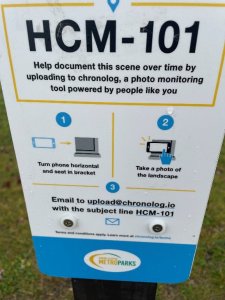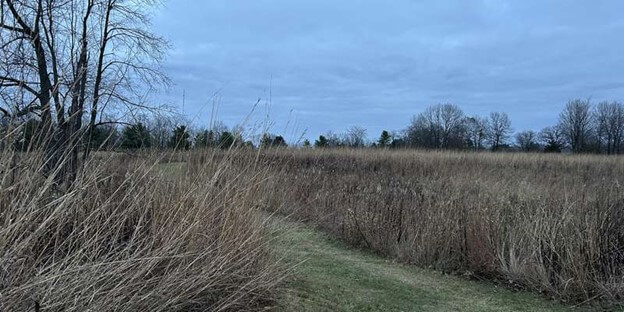Chasing Time – Recording the Changing Landscape + Film Sneak Preview
November 24, 2024
How do you capture landscape changes over time? What would we learn if we could keep a photographic record of those changes, and how would it influence our behaviors? Metroparks’ visitors and staff have an opportunity to engage with a new short film documentary called “Chasing Time” that tracks changes in glacial ice over a 15-year period.
We are all experiencing environmental changes. We have seen warmer winters with less snow, heavier rain events and hotter summers. We can all play a part in taking care of our planet, and this film reminds us that most people know what they can do to be more environmentally friendly – things like recycling, reducing paper use, conserving water and electricity, etc. – but we often do not. They use an analogy to inspire us to consider our actions – “No one picture can change the world. No one person can change the world. This work is a relay race. Each of us runs our leg and then we pass the baton. Together all of our stories can reshape the future.”
Changing Landscapes
“We live in a region shaped by glaciers that were in Michigan thousands of years ago. When we see the real-time changes occurring in glacier coverage in other parts of the world, it’s a very tangible illustration of the environmental changes that are happening in our lifetimes. I’m appreciative of Impact Studios’ support in allowing us to host this online sneak preview of Chasing Time for our community at no cost to the Metroparks or the community.” said Jill Martin, Community Outreach Interpretive Service Supervisor for the Metroparks.
Interested viewers have the opportunity to watch the new documentary for free through the following link until Friday, December 6. Click on the link and create a free account. Once you start watching the video, you will have access for 7 days.
This film focuses on the ending of the 15 year long “Extreme Ice Survey” project with images captured in the same place through time, showing the rapid loss of ice. If you are short on time, the time lapse compilations of this study start at about the 26:30 time marker.
As you watch the film we encourage you to think about these questions and how you can take what you learn in the film and apply it to everyday changes.
Just like in Chasing Time, no one does their work in this world alone. We are either part of a community, part of a long lineage of people who’ve done the work before us, or both. How is our work easier when we’re part of a collective? What are the practices that we can employ to create healthy movement communities? In a community focused on a collective goal, what is the role you like to play most?
Chronicling Landscapes
Although the film is based in other places in the world, the concepts remind us that technology is greatly impacting the types of studies that can be completed and increasing the role the public can play in them. As we all engage more directly in the work, we feel more connected and can initiate better actions and solutions as a community of partners.
Locally, at the Metroparks level, we are interested in what it looks like through time when specific natural areas are managed with prescribed burning to reduce nonindigenous plants as well as seasonal changes from year to year, and the changes wrought by ecological restoration.
 One way that the Metroparks are inviting park visitors to capture our own changing landscapes is through the installation of Chronolog photo stations. These Chronolog stations, soon to be located at Lake St. Clair, Stony Creek, Dexter-Huron, Willow, Oakwoods, and Lake Erie Metroparks provide an opportunity for visitors to take a cell phone picture and upload it to the Chronolog website. The station includes a bracket for orienting all cell phone photos in the same direction, taking an image of the same view over time. Each station also includes directions for uploading or sharing the photograph with Chronolog. Chronolog will then create the timelapse view of these changing landscapes.
One way that the Metroparks are inviting park visitors to capture our own changing landscapes is through the installation of Chronolog photo stations. These Chronolog stations, soon to be located at Lake St. Clair, Stony Creek, Dexter-Huron, Willow, Oakwoods, and Lake Erie Metroparks provide an opportunity for visitors to take a cell phone picture and upload it to the Chronolog website. The station includes a bracket for orienting all cell phone photos in the same direction, taking an image of the same view over time. Each station also includes directions for uploading or sharing the photograph with Chronolog. Chronolog will then create the timelapse view of these changing landscapes.
Through time, these images showcase the changes to our local park ecosystems through the lens of visitor’s cell phone cameras. Community-based science projects like these can help land managers better understand natural and human-made changes as well as plan for the future. They also engage the public through longer term and more scientific experiences within their favorite parks.
The Chronolog Photo Station located on the Habitat Trail at Stony Creek Metropark Nature Center (near intersection sign post #5) overlooks a restored prairie. While November views include tall, brown grasses and seedheads, spring views may show a prescribed burn with all those November plants cleared by flames, and summer likely showcases a variety of native flowers in full bloom.

Caption: November view from a Chronolog station at Stony Creek Metropark along the Habitat Trail. How do you think the landscape will change through time?
Chronolog photo stations will be installed in the coming months, and we encourage you to discover and engage with them. Park users will be contributing to our understanding of our own southeastern Michigan landscapes and how they’re changing, with and without our intervention. The image gallery, created by different cell phone photographers through the year, become a time lapse video, a valuable tool for observing change through time.
So as you are experiencing these natural landscapes consider your personal impact on them. What are you doing to help or hurt them and how can you inspire your inner circle to be a part of positive change to protect and improve them?
